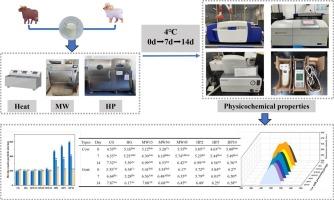Variations in quality attributes of cow and goat milk subjected to microwave and high-pressure treatments over a two-week storage period
IF 6.8
1区 农林科学
Q1 FOOD SCIENCE & TECHNOLOGY
Innovative Food Science & Emerging Technologies
Pub Date : 2025-08-25
DOI:10.1016/j.ifset.2025.104200
引用次数: 0
Abstract
This study investigates the effects of heat, microwave (MW), and high-pressure (HP) treatments on microbial inactivation, physicochemical properties, and storage changes in cow and goat milk to clarify processing-induced differences. MW (1000 W, 45 s) and HP (500 MPa, 5–10 min) significantly reduced microbial counts and eliminated coagulase-positive Staphylococci, indicating improved microbial quality. HP treatment further decreased brightness (L*) in both milk types, and L* declined significantly across all treatment groups during the 14 d storage period, suggesting altered visual quality. HP treatment also enlarged casein micelle and fat globule size, while storage resulted in a reduction of micelle size and an increase in fat globule size in cow milk. MW treatment notably increased α-helix content in goat milk proteins, whereas HP treatment reduced α-helix structures while increasing β-sheet and random coil conformations in both milk types. During storage, both MW and HP treatments exhibited further reductions in α-helix content and increases in disordered structures, although HP-treated samples maintained greater structural stability. MW and HP also enhanced milk protein fluorescence intensity and surface hydrophobicity, both of which declined progressively during storage, likely due to aggregation and conformational changes. These results support MW and HP as viable non-thermal pasteurization technologies that enhance microbial safety and influence structural attributes of dairy proteins. Further optimization is needed to improve product stability and shelf life, with process conditions customized to specific milk types for industrial application.

经过微波和高压处理的牛奶和山羊奶在两周的储存期内质量特性的变化
本研究考察了高温、微波和高压处理对牛奶和羊奶微生物灭活、理化性质和储存变化的影响,以阐明加工引起的差异。MW (1000 W, 45 s)和HP (500 MPa, 5-10 min)显著降低微生物数量,消除凝固酶阳性葡萄球菌,表明微生物质量得到改善。HP处理进一步降低了两种乳汁的亮度(L*),在14 d的储存期内,所有处理组的L*都显著下降,表明视觉质量发生了改变。HP处理也增大了酪蛋白胶束和脂肪球的大小,而储存导致牛奶中胶束大小减小和脂肪球大小增加。MW处理显著提高了羊奶蛋白中α-螺旋结构的含量,HP处理降低了羊奶蛋白中α-螺旋结构的含量,增加了羊奶蛋白中β-薄片和随机螺旋结构的含量。在贮藏过程中,MW和HP处理的样品α-螺旋含量进一步降低,无序结构增加,但HP处理的样品保持了更大的结构稳定性。MW和HP还增强了牛奶蛋白的荧光强度和表面疏水性,这两种特性在储存过程中逐渐下降,可能是由于聚集和构象的变化。这些结果支持MW和HP作为可行的非热巴氏灭菌技术,可以提高微生物安全性并影响乳制品蛋白质的结构属性。需要进一步优化以提高产品稳定性和保质期,并为工业应用定制特定牛奶类型的工艺条件。
本文章由计算机程序翻译,如有差异,请以英文原文为准。
求助全文
约1分钟内获得全文
求助全文
来源期刊
CiteScore
12.00
自引率
6.10%
发文量
259
审稿时长
25 days
期刊介绍:
Innovative Food Science and Emerging Technologies (IFSET) aims to provide the highest quality original contributions and few, mainly upon invitation, reviews on and highly innovative developments in food science and emerging food process technologies. The significance of the results either for the science community or for industrial R&D groups must be specified. Papers submitted must be of highest scientific quality and only those advancing current scientific knowledge and understanding or with technical relevance will be considered.

 求助内容:
求助内容: 应助结果提醒方式:
应助结果提醒方式:


